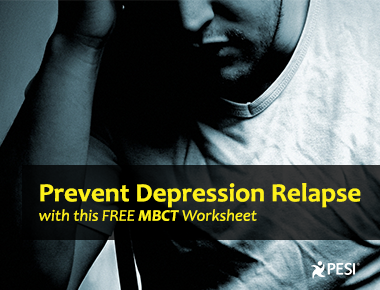5 Ways to Help Your Client Break Their Depression Cycle
FREE Depression Relapse Prevention Worksheet
PESI Team, Richard Sears, PSYD, PHD, MBA, ABPP

Do you have a client stuck in a vicious cycle of depression?
Depression has been called the “common cold” of mental health. Far beyond the normal experience of feeling sad, major depressive disorder significantly impacts an individual’s daily functioning. Even though depression is very common, it can be challenging for many professionals to treat.
You may have brilliant insights into how the depression got started, or why it is continuing, or even the family dynamics that took place during childhood that contributed to it—but somehow all of that has to translate into clients becoming more active in their lives.
Helpful tips in depression recovery and prevention
One of the best ways therapists can help clients do this is called “behavioral activation,” which is a fancy way of saying, “get moving.”
The scientific benefits of movement and exercise on depression and general mental health are remarkable. In fact, physical exercise is now considered an evidence-based intervention for depression (Deslandes, 2015; Rosenbaum, Tiedemann, Ward, Curtis, & Sherrington, 2015).
Some easy ways clients can accomplish this include:
- Getting out of bed or off the couch. Have your clients set three goals around the house for the day. It could be as simple as doing the dishes, doing their laundry, and vacuuming. Getting them up and moving will start to pay off as they gain momentum.
- Taking a walk around the block. If they feel like it's too much to even get themselves all the way around the block, break this down into small steps to make it feel more manageable. They can start with walking down the driveway to get the mail every day, then move on to walking down the next block/corner, and work their way up until they reach their goal.
- Going out to the store or to a park. Starting out with a concrete list of things they need from the grocery store can help your clients have one less thing to worry about as they look towards getting out into the community more. To get them involved in more enjoyable activities, they can think of what they might like to do if they were to go to the park. Set an assignment of going to the park and reading outside for a half hour if they're willing to try it.
- Doing things with friends or family members. Because clients tend to isolate more when they're feeling depressed, it's also important to encourage them to get out with others again. Give them a weekly challenge of setting a walking date with a neighbor, scheduling a family dinner, or reaching out to three friends.
- Engaging in a hobby that they used to enjoy. While it may seem hard for them to think of things they would like to do now, they can start by making a list of what they used to enjoy. From there, have them pick one activity that they will engage in during the next week.
Here’s the hard sell -- a client experiencing depression will not feel like doing those activities, and they will not feel better right away. This is why it can be very helpful to get the support and encouragement of friends and family.
It is also vital to help your client recognize when they are about to get caught in a depressive relapse. If clients can be mindful to the warning signs of a relapse, they can take action to prevent a full episode of depression from coming back.
This is important, as it is much easier to act in the early stages of a relapse than it is to pull oneself out of the pit of a major depressive episode.
Free depressive relapse prevention worksheet
To assist with helping clients identify the early signs of a relapse and develop a relapse prevention plan, Dr. Sears has created this free worksheet.
» Download your free worksheet here.
Use this resource with your clients so they can spot the warning signs of a depressive relapse and be proactive in preventing it.
Earn your certificate in MBCT
Looking for more resources on Mindfulness-Based Cognitive Therapy (MBCT)? Check out my Certificate Course.
This comprehensive online certificate training provides a session-by-session guide to incorporating MBCT therapy in your clinical practice as well as shows you concrete, practical ways to incorporate it for symptoms such as PTSD, anxiety, chronic pain, addictions, and depression.
Richard Sears, Psy.D., PhD, MBA, ABPP, is a licensed psychologist in Cincinnati, Ohio, board certified in clinical psychology by the American Board of Professional Psychology (ABPP), runs a private psychology and consultation practice, and is the Director of the Center for Clinical Mindfulness & Meditation. He is also clinical assistant professor at Wright State University School of Professional Psychology, clinical/research faculty at the UC Center for Integrative Health and Wellness, volunteer professor of Psychiatry & Behavioral Neurosciences at the UC College of Medicine, and a research/psychologist contractor with the Cincinnati VA Medical Center.
His most recent books include: Cognitive Behavioral Therapy & Mindfulness Toolbox (PESI, 2017); Mindfulness: Living Through Challenges and Enriching Your Life in this Moment (Wiley-Blackwell, 2014); Perspectives on Spirituality and Religion in Psychotherapy (PR Press, 2014); Building Competence in Mindfulness-Based Cognitive Therapy (Routledge, 2015); and Mindfulness-Based Cognitive Therapy for PTSD (Wiley-Blackwell, 2016). Dr. Sears is lead author of Mindfulness in Clinical Practice (PR Press, 2011) and Consultation Skills for Mental Health Professionals (Wiley, 2005).
Dr. Sears is a fifth-degree black belt in Ninjutsu, and once served as a personal protection agent for the Dalai Lama with his teacher, Stephen K. Hayes. He has studied the Eastern Wisdom traditions for over 30 years, receiving ordination in three traditions, and has been given transmission as a Zen master.
Learn more about his educational products by clicking here.
Topic: Anxiety/Depression | Grief | Mindfulness
Tags: How To | Mindfulness | Therapy Tools | Tools




